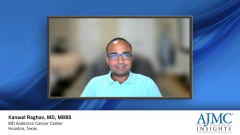
Effects of Chemotherapy on HER2+ Targeted Therapy Outcomes
HER2+ targeted therapy outcomes are evaluated, particularly when combined with prior or subsequent chemotherapy.
Episodes in this series

Kanwal Raghav, MD, MBBS: There are some data on this, though not extensive. There’s no biological rationale to believe that a patient with HER2-amplified colorectal cancer would have resistance to the standard-of-care chemotherapy, which is FOLFOX [folinic acid, fluorouracil, oxaliplatin] or FOLFIRI [folinic acid, fluorouracil, irinotecan]. But there are preclinical and clinical data from retrospective analyses that clearly show that presence of HER2 amplification is a negative predictive biomarker for anti-EGFR efficacy, so drugs like cetuximab or panitumumab probably don’t work as well in HER2-amplified patients as they do in HER2-nonamplified patients.
Our group looked at these data, wherein we looked at 2 different cohorts of patients in the second- and third-line settings who were treated with an anti-EGFR based treatment, and we found that patients who had HER2 amplification had a median progression-free survival of about less than 3 months compared with about 8 to 9 months when they weren’t HER2 amplified.
Within that study, we also looked at the same patients in the first-line setting, where they got a non–anti-EGFR based treatment, and we didn’t find any differences in survival outcomes. Therefore, we feel that this treatment impact or the predictive nature of HER2 amplification is exclusive to the use of anti-EGFR agents, and thereby we should always consider testing for HER2 before we expose patients to anti-EGFR for a couple of reasons. No. 1, anti-EGFR probably isn’t going to work, and therefore the risk-benefit profile isn’t what you want for your patients. You have good and active anti-HER2 agents and you could direct these patients toward some of the clinical trials that are open. Given that, we have to remember that amplification, unlike mutation, isn’t a binary variable. It isn’t either present or absent. It’s probably a spectrum from low-level amplifications to high-level amplifications, and it’s possible that the effect of anti-EGFR and the efficacy of anti-HER2 therapy could differ based on the level or the place on that spectrum.
Overall, as far as the adverse effect profile of dual anti-HER2 therapy and anti-HER2 therapy, these therapies are fairly well tolerated. They have certain specific adverse effects [AEs]. The cardiac AE is the most obvious one. In all these cases, we always check for heart function before we begin and then routinely at frequent intervals to make sure we aren’t causing any long-term damage. Small-molecule tyrosine kinase inhibitors, such as lapatinib and tucatinib, have diarrhea associated with them. In most cases, patients tolerate these therapies fairly well.
One of the AEs of the antibody-drug conjugate trastuzumab deruxtecan that we have to look out for is interstitial lung disease. This can potentially be a severe as well as life-threatening AE, so one needs to keep their clinical suspicion high for development of any interstitial lung disease. Because it’s also a targeted chemotherapy, there’s some degree of bone marrow suppression with these agents. Granted, there are no randomized comparisons, but the adverse effect profile isn’t as severe as other second- or third-line chemotherapy agents or targeted agents that are in the clinic for colorectal cancer.
Transcript edited for clarity.
Newsletter
Stay ahead of policy, cost, and value—subscribe to AJMC for expert insights at the intersection of clinical care and health economics.












































